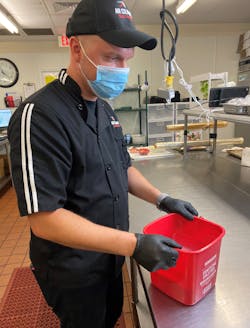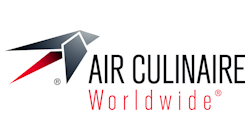Food safety practices have always been a priority for caterers serving the business aviation community, however the pandemic has brought a new dynamic and essential safety protocols to professional commercial kitchens as heightened safety has become a focus for world travelers and flyers traveling for business and pleasure.
Roger Leeman, vice president of operations, Air Culinaire Worldwide, stated that their kitchens have always practiced top-level food safety and sanitation practices prior to the rise of COVID, with every team members investing significant training and time cleaning and sanitizing work surfaces to prevent cross-contamination and foodborne illness. However, the pandemic has created a more threatening hazard into food production operations.
“We’re typically dealing with biological, chemical and physical safety hazards when it comes to food. Now, we suddenly face a new normal and challenge which is an unfamiliar threat in the form of a coronavirus, so it has required training, time and new resources in order to mitigate this new threat,” Leeman said.
Used to fending off foodborne illnesses, the airborne and repository nature of COVID-19 brought a challenge that kitchens have never experienced. In this new environment, cleaning surfaces is no longer good enough; sanitization and sterilization has became the priority and it’s required in every area of operations, from the kitchen, to the office and vehicles, as well as in new personal hygiene practices.
“Within our new COVID-19 protocols, it’s not just the surfaces that we have to clean and sanitize. We sterilize walls, air vents, offices and logistics equipment,” Leeman said. “It’s the inside of the delivery vehicles, both the front, the cabin where the driver sits, and in the back where the food is stored for distribution. We had to create methods and procedures to achieve that to ensure the safety of our teams, partners and clients.”
Sanitizers used in other areas of the industry don’t translate to the kitchen. Disinfecting agents need to be food safe. What Air Culinaire has implemented is the industry standard in COVID sterilization, hypochlorous acid (HCLO), a food safe disinfectant that mitigates the virus.
“It’s a mixture of salt, water and electricity is added to create the hypochlorous acid, it’s the same germ-killing substance your immune system makes,” Leeman described. “If you’ve been to the dentist and gargled with an antiseptic mouthwash, you’ve probably used a hypochlorous acid solution.”
In conjunction with the HCLO formula, they also utilize foggers to quickly disperse the solution in the form of an aerosol mist to all the areas of the kitchen, vehicles, offices and beyond. Air Culinaire serves the business aviation community via 20 kitchens across the US, along with three kitchens in Paris and London. Leeman said all their kitchens are fogged daily.
“The way we’ve organized the system in the kitchen makes it simple for operators to practice best in class safety and sanitation practices, and our kitchens vary in size, and our system works for all locations. Literally, it’s a closing duty at the end of the night, when all the employees leave. Because the product is so safe, we can fog the entire kitchen, and then leave the kitchen and allow the sanitizer to dry in place so every square-inch is sanitized through microbial disinfection,” Leeman said.
Leeman said the new protocols were immediately developed as soon as the pandemic hit and the greatest pain point for them was tackling the unknowns of the virus in the early days.
“The challenge and question was, ‘Are we doing enough?’ We’re already washing our hands, and now we’re adding a sanitizing step on top of washing our hands. The next question was, ‘What do we need to do to ensure the safety of the catering and the safety of our employees and clients too?’ It was two-fold with several variables early in the process. The unknown, in the beginning, was the difference,” Leeman recalled.
The unknowns extended to the passengers and pilots, with each taking a different approach to tackling the issues.
Leeman said passengers were being cautious and ordering catering during the pandemic’s early days, either bringing food with them or ordereing outside of the aviation sphere. Inversely, pilots weren’t trusting of the outside and stuck closer to aviation caterers.
“We began to see a trend toward far more pilot meals than passenger meals. You could see there was a correlation there because the passengers didn’t really want anything to come into the environments, and pilots, they did the same thing, except their environment already included the business aviation caterer. It was all less risky. We’ve even delivered meals to hotels where the pilots stayed, because they didn’t want to purchase meals from restaurants or hotels that they weren’t sure practiced the same safety protocols that we practice,” Leeman said.
Over time, concerns lessened with passengers once again ordering catering, but still with safety on their mind. Some passengers now order individually wrapped dishes and items, rather than shared trays, for example.
“You can see that ordering preferences have changed, where some are less likely to share and request individual meals,” Leeman said. “It’s gravitated to more small plates and individual dishes verse artisan shared displays.”
The Food Safety Renaissance
As the pandemic’s grip took hold, there was a renewed focus on food safety, said John Detloff, chief operations officer, DaVinci Inflight Training Institute. Detloff said that he’s been flooded with calls and messages concerning COVID-19 and what impact it would have on caterers, flight crews and food hygiene practices.
“With COVID-19, I get calls at least two to 10 times a week of flight crews and corporate flight departments calling us to say, ‘How should I handle the food? What training should I have my flight crews have when it comes to food safety?’” Detloff said.
This is in stark contrast to what Detloff said has been his experience during his career as an executive chef and food safety trainer. Prior to the pandemic when he would lecture on food safety at conference, sometimes half the audience would leave.
The unknowns of the pandemic, though, brought everyone involved in the process of getting food from kitchen to aircraft back into the necessary subject of food safety.
It’s been the silver lining of the pandemic, because, as Detloff explained, aviation caters were already well set up to tackle the demands of COVID-19 by simply following the food safety best practices they always had, only now with the addition of new sanitization methods and mask wearing added into the mix.
“The food safety practice and handling has always been the same for the catering side, but not so much as far as the flight crew side and the FBO, and I think we’re all now working on the same page to making sure that we’re all following the food safety practices as best we can,” said Detloff.
Detloff added that with COVID-19 being an airborne illness, aviation kitchens have a leg up thanks to their many vent hoods keeping the air in the kitchen constantly circulated.
“Aviation caters do a great job with food safety, but when it came to delivering the food, and the flight crew or the FBO taking the food, there was really no regulations,” Detloff said. “I think now especially with COVID-19, everybody’s taking the proper measures when it comes to food safety.”
One thing Detloff said an FBO and business flyer can do is make sure they work with an aviation caterer, who are held to catering-specific standards by organizations like the FDA and local health departments compared to other food service providers.
“They take all the necessary measures to make sure that they’re taking the food serious when it comes to food safety. They also use a cook to chill method, which is controlling the temperatures of the food the very best way compared to restaurants and hotels, which do the cook to serve method, where they cook the food and you’re really meant to eat it within those four hours,” explained Detloff.
Having that proper training is crucial to food hygiene success. Knowing what the proper temperature to cook and then store food at, along with how to clean, sanitize and prevent cross contamination makes all the difference.
“So therefore, making sure that you’re killing any bacteria that could possibly be on the food,” Detloff continued. “I think those are some of the best practices right now is really using the people that prepare the food properly in using the aviation caters.”
Leeman agreed, saying that food safety and food quality go hand-in-hand; you can’t have one without the other.
“The requirements for the quality of the items that we produce are dependent upon practicing best in class food safety standards. I mean, you don’t get crisp, crunchy lettuce by allowing temperature abuse. Everything goes hand-in-hand to have the best experience for the passenger on board,” Leeman said.
And now with more people focused on food safety, that quality of service can continue into the air.
“Back in the day, everybody thought it was just the caterer’s responsibility on food safety, but it’s all of our responsibility when it comes to food safety. Because the caterer can follow all the steps properly. But when it’s delivered to the FBO, if they don’t follow the steps properly, it can be contaminated. At the same time if the FBO follows all the steps and delivers to the flight crew, and they don’t follow the proper steps it can be contaminated,” Detloff said.
The Future of Food Safety
Detloff said he doesn’t see the focus on food safety waning post-pandemic.
“It’s our job as flight crew members, to know the training and how to mitigate the risk. And I think nowadays with COVID-19, I think everybody’s really trying to follow the proper protocols and inspecting where they’re getting the food, what FBOs they’re using that are following the food safety protocols that the FDA recommends. And I think that will be here to stay as well,” he said.
Leeman added that while the pandemic and it’s impacts on the industry and world cannot be overstate, he believes everyone will be better for it in the long run.
“We haven’t been any safer, and when it comes to safety and those kinds of things, we’ve passed a threshold of no return, and these heightened protocols are here to stay,” Leeman said. “I think that COVID is a terrible, terrible thing. But from a business standpoint and what our product is and what we do, it has actually made us be very innovative and think all the way through the process in ways that we hadn’t before.
“In the end, I think your business aviation caterer is much, much better off now than even before COVID,” he continued. “Because people weren’t as interested in food science or health and safety as they are now, and that has pushed health, safety and sanitation in food production for every organization in the hospitality space.”






